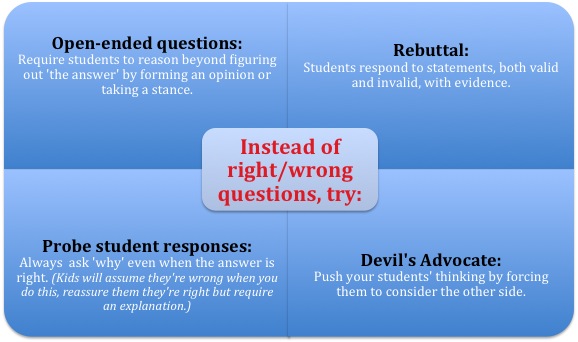Recently I’ve been thinking and reading a lot about checking for understanding and using on-the-spot assessment strategies to figure out which students have gaps in their learning and, perhaps more importantly, where those gaps are occurring. In my last two cents I asked the questions: ‘How do you know your students are actually learning what you want them to?’ and ‘When your students leave the classroom, do you know how well each of them understood the day’s objective?’ Since writing that piece I’ve been doing a lot of reading about this topic and I would like to offer a few of the best tips I’ve come across. Keep in mind that this brand of assessment is not just a simple check-list of tips and tricks but rather something akin to a chess game, in which your next move needs to be dictated by the response and actions of your students. These strategies are a good place to dip your toe into the water, so to speak. They’ll give you a foundation to start with, they aren’t magical in any way, but employing these strategies will improve the learning in your classroom. Have a look and try some out in your class. My tip, start with number one and add a few others, it is essential!
1. Take them to teacher’s college:
Our students are smart, they’re perceptive, they get it, and most of all, they like knowing what’s going on! Explain the new strategies you’ll be employing in class, have a conversation with your students about what you’ll be doing and why. Let them join the conversation. When they’re aware of the strategy being used they can understand the intended results, which leads to increased awareness and engagement. Inform the kids, they’ll buy in, and you’ll be amazed at their responses and the feedback you can receive when students are part of the conversation!
2. Learn to teach with no hands:
Riding a bike with no hands takes practice and, for some, can be a daunting task (especially in China!) Teaching with no hands may put you out of your comfort zone as well. What do I mean? What would happen if kids weren’t allowed to raise their hands to answer questions? The best way to create an environment where participation is mandatory and expected from all students is to do just that, expect it from all students! Popsicle sticks with names seem so 3rd grade but this strategy (we can call them equity sticks if that feels better) will ensure that all students are held accountable for thinking. Ask the question (see below for strategies on questioning) before you choose the respondent. If every student knows they may have to answer the question, they are all forced to engage and think. This strategy may not be popular and it will take some time. Explain it to kids, the eager students are going to feel frozen out (they can’t show off how much they know) and the quiet non-participants will be forced to contribute (*Note: For your ESOL and reluctant students, try prepping them by letting them know you’ll be calling on them next and then forgoing the random draw for that particular question. This allows more time to process and helps eliminate the nervousness of being cold-called. You might also try “teacher’s choice”, “free pass”, “ask a neighbor”, “check my notes” and other ‘wild-card’ sticks to spice things up.)
3. Questions that ‘work’ for everyone:
Okay, so if you’re calling on random students how do you prevent getting a bunch of “I don’t know” responses? Allow ALL students to engage with your questions on multiple levels; don’t just ask questions that require a certain ‘correct’ answer, try some other options:
Example: In math class, instead of solving a problem, give two problems and ask students to explain which problem is harder. This requires everyone to solve the problem and allows for more advanced thinkers to ponder further, plus it allows you to discover where the misunderstandings lie for those who are struggling. Another version of this may ask students to create a third problem that is similar to the original two problems, allowing the students to find commonalities and then create something new that fits into the group.
4. Wait for it!
Slow down! Too often we are in such a hurry to finish a lesson that we don’t check to make sure the intended learning is happening. After asking a question, just wait, give students time to think and process. ‘Wait time’ often comes with uncomfortable pauses but it also comes with increased participation and understanding. If too many pauses feel uncomfortable, consider a think-pair-share followed by a journal entry routine. Allow students a few seconds to think, then a few more to pair with a neighbor, and enough time to write a sentence or two in a special section of their notebooks. Students can write their thinking or perhaps what they learned from their partner. Then share, everyone should be able to share either their own answer or their neighbor’s. The biggest issue with any ‘wait time’ strategy is the amount of time it takes, so plan ahead and budget appropriately while also picking your spots, find your balance.
5. “Before anything else…”
Preparation is the key to success. All of the strategies mentioned require time and effort in preparation. Teachers who have been employing these strategies for many years need not plan much further in advance than a few minutes or even seconds. However, if these are new to you, sit down beforehand and plan. Look for places to include these strategies in your current lessons, plan time to have conversations with your students about their learning. The amount of time and energy that one well thought out lesson may take is dwarfed by the incredible increases in learning gained from a prepared teacher!

2 thoughts on “Ready-to-use Tools: Checking for Understanding”